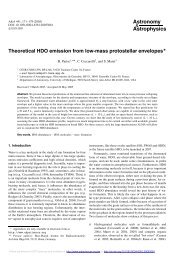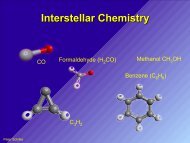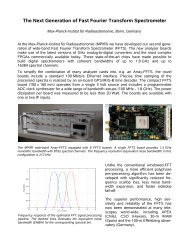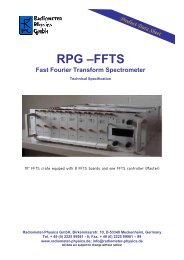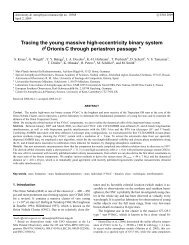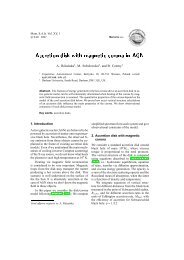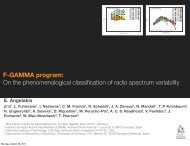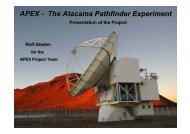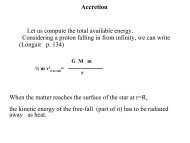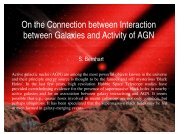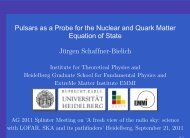VLBI analysis with c5++ - Mpifr-bonn.mpg.de
VLBI analysis with c5++ - Mpifr-bonn.mpg.de
VLBI analysis with c5++ - Mpifr-bonn.mpg.de
You also want an ePaper? Increase the reach of your titles
YUMPU automatically turns print PDFs into web optimized ePapers that Google loves.
• <strong>c5++</strong> and <strong>VLBI</strong>Content– Multi-technique space geo<strong>de</strong>tic <strong>analysis</strong>software– <strong>VLBI</strong> <strong>analysis</strong> and some features• Automated ambiguity resolution• Real-time UT1 estimation• Software validation• Upcoming release• Summary and outlook
<strong>c5++</strong> a multi-technique space geo<strong>de</strong>tic <strong>analysis</strong> softwareDeveloper teamOpen-sourcelibrariesNetCDFothersboost<strong>c5++</strong> librarySLR LLR GNSSGEOetc.Deepspace<strong>VLBI</strong>this talk
Some features and results
Automated processing of UT1 sessionsCurrentlyAutomation<strong>with</strong> <strong>c5++</strong>CorrelationAdding station log infoAmbiguity resolutionIonosphere correction(partly)XGeo<strong>de</strong>tic <strong>analysis</strong> (UT1)
Automated ambiguity resolution and UT1estimation <strong>with</strong> <strong>c5++</strong>1 Use X and S-band as in<strong>de</strong>pen<strong>de</strong>nt observationswhich share a common clock + an offset betweenthe bands2 Estimate only clock3 Look at residuals and shift ambiguities accordingto X/S band spacing4 If none of the residuals exceed the correspondingambiguity spacing stop iteration5 Compute ionosphere correction6 Compute UT1
Example:Wettzell-Tsukuba, 2006/11/18X-bandresidualsS-bandresiduals
Single Baseline UT1 estimation• In accordance to IERS 2003 conventions• Optional SNR filter to reject observation <strong>with</strong> lowSNR• Estimated parameters:– Quadratic clock (3 unknown)– Troposphere ( 2 unknown)– UT1 offset (1 unknown)• LSQ/Gauss-Markov Mo<strong>de</strong>l• 3 outlier test and re-run possible• Output results in IERS format
Results from automated re-processing• using correlator output• using station logs• Processing all INT2 sessionsbetween Jan. 2006 andMay 2010• No human interaction• Compare against CALC/SOLVE based resultscomputed by GSI
Software validation• We joined the IVS“Comparison Campaign of<strong>VLBI</strong> Data Analysis Software”±1mmMany thanks to L. Plank for feedback during this evaluation
Next release and further <strong>de</strong>velopment• Implements IERS 2010 conventions• Prepared for new <strong>VLBI</strong> data format• Allows multi-baseline ambiguity resolution• Input/output of SINEX files• Implements a more sophisticated outlier <strong>de</strong>tectionalgorithm• Kalman filter for time-transfer by <strong>VLBI</strong> (i.e. NICTs mainresearch target starting from April 2011)• Combination of space geo<strong>de</strong>tic techniques on theobservation level• Space craft navigation of <strong>de</strong>ep-space missions (JAXA)
Summary• Benefit from large <strong>de</strong>velopment team• modules provi<strong>de</strong>d by experts in the corresponding fields• Usable across different space geo<strong>de</strong>tic techniqueconsistency• Only a few additional <strong>VLBI</strong>-only modules required• The <strong>VLBI</strong> module of <strong>c5++</strong> has been applied to fully automate<strong>de</strong>stimation of UT1 (being used by GSI, results submitted tothe IERS for evaluation)• Software validated <strong>with</strong>in the IVS comparison campaign• Automatically processed UT1 results agree well <strong>with</strong> manuallyanalyzed CALC/SOLVE estimates
Outlook• Make use of parallel architectures to speed upcomputation intensive parts (mainly orbit module,less affecting <strong>VLBI</strong>)• Following the goal of GGOS, we’d like to provi<strong>de</strong> aflexible multi-technique space geo<strong>de</strong>tic <strong>analysis</strong>software• Support other applications as well– Time and frequency transfer by <strong>VLBI</strong>– Space craft tracking
Thank you very much for yourattention !Acknowledgments:GSI, Japan (data, real-time tests, etc.)Vienna Univ. of Techn. (software validation)IVS (data)IERSFurther reading:Hobiger T., Otsubo T., Sekido M., Gotoh T., Kubooka T. Takiguchi H., Fully automated <strong>VLBI</strong><strong>analysis</strong> <strong>with</strong> <strong>c5++</strong> for ultra-rapid <strong>de</strong>termination of UT1, submitted to Earth, Planets, Space,2010.



